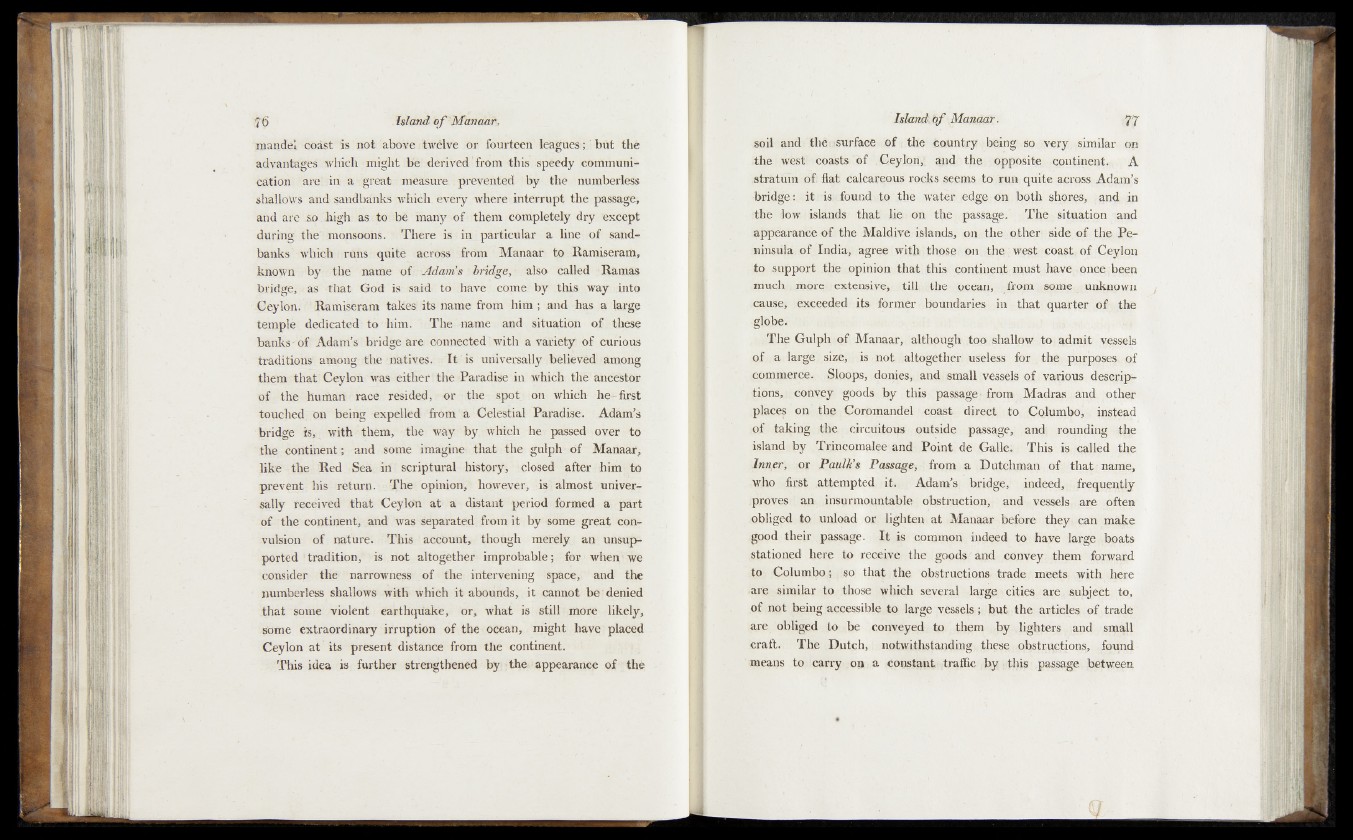
Baande! coast 5s nót abos?e itwélve Pr fourteen leagues/j. ’ büt thè
adyantages which might b'e; derived from th is .spéedy communication
are! in a great measure prevented by the numberless
shallops andv sandbanks which.-every where interrupt the; passage*
and are so . high as to h é many of them completely dry except
during th'e'hmonsdohs. There is • in particular a line of sandbanks
which ! rUhs: quite across from Manaar to Ramiserarii,
known by- th e name of Adam’s ’ bridge, also called Ramas
bridge, ft as that God is said to have, come by this way /.into
Gey Ion. Itamiseram takes! its name from him ; and has a large
temple dedicated| tó ' him. ' \ The name and situation of r these
banks-of Adam’s bridge are connected ’ with a variety of curious
traditions' among the natives. // I t ' is universally believéd among
them that Ceylon was eitheri the Paradise in which tlië' ancestor
of the human- race resided, or the- spot on which he-*-first
touched on being expelled from a Celestial Paradise. Adam’s
bridge is, with them, the way ' b y : which he passed over to
the continent; and some imagine that the gulph - óf Manaar,
like the (Red |jSea; in f scriptural history, closed after him to
prevent his return. The opinion,v however, is" almost universally
received that Ceylon at a distant period, formed a part
of the continent, and was separated from it by some great convulsion
of nature. This account, though merely an unsupported
'tradition, is not altogether improbable; fo r1 when*we
consider the narrowness of the intervening space,- and the
numberless shallows with which it abounds, it cannot be denied
.that some violent earthquake, or, what is still more likely,
some extraordinary irruption of the ocean, might have placed
Ceylon at its present distance from the continent.
This idea is further strengthened by the- appearance of the
Island, b f .Manaar •
soil andïMiêosurfaee -©f j!the country being so very similar -op
,the west' coasts M ÆlyfeîM dbd:'ithfeB^pppsite -qontinenfgp A
.stratum of* flat calcareous rocks seems toyrun quite acrossAdanfs
-bridge: it is (.found to th e waterjedgç-oh),bofh shoFves? fgnd in
th e tew . islands that lie o'n the passage/ The - situation and
Appearance-of the Maidive islands, o n g& e ^ th e r side.of the Pe-
/ninsùlà, of. India, agree with thqSgf-pn th e ; west; ; coast* of Ceylon
to support the .opinion that this contiiient;?nust h^veppnçe^been
much., more extensive, . tiUésthe £pcean, j-fro-m some unknown
causes /exceeded its former .boundaries in that quarter of the
-glbbei H
(-.rThe Gulph ©f Manaar,, 'although too shallow to
ofrfîàrlSfgPBsteei!, ds f e ; „ tl^ iiq g jg s e s ^ ^
^commerce. Sloops, doniesy.and, small [vessels of, various descriptions,^
tceip^eÿ goods, by this passage • from .Madras„i.&nd other
places on the Coromandel eoast direct), ' to^.Colunibo^ -, instead
iftf: taking the, circuitous outside, passage* and rounding the
islands by .Tipncomalee and Point de Galle. This is qalled the
Inner, or IfauUt’s Passage, from a Dutchman of that name,
who first attempted, at. Adam’s bridge, indeed,t frequ^tly
.proves an. .insurmountable obstruction, and ' vessjels.,,atq .often
obliged to unload or lighten at Manaar -before they? can make
good their- passage. I t is common..; indeed to haye large/.boats
stationed here tP receive the goods/ and-,?ebhveyr them forward
to Colombo <; i;so th a t, the obstructions, trade meets, with daere
■are similar to those which several large, * cities are snhjort to, ;
of not being /accessiblejto large vessels ; bu t the articles pfs:. trade
are obliged to be conveyed to them ...by. lighters and small
craft. The Djutqh, n o t w i t h s i a B d / m g ; fQiïttcI
means to carry op a constant traffic by s&hjp : between